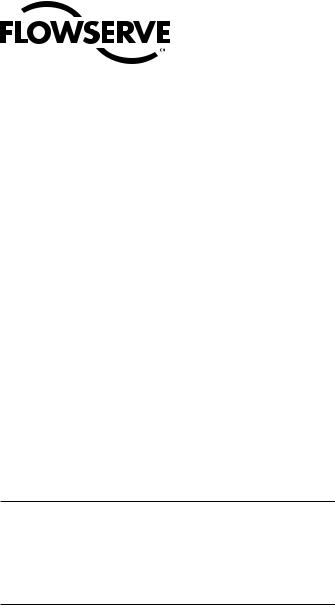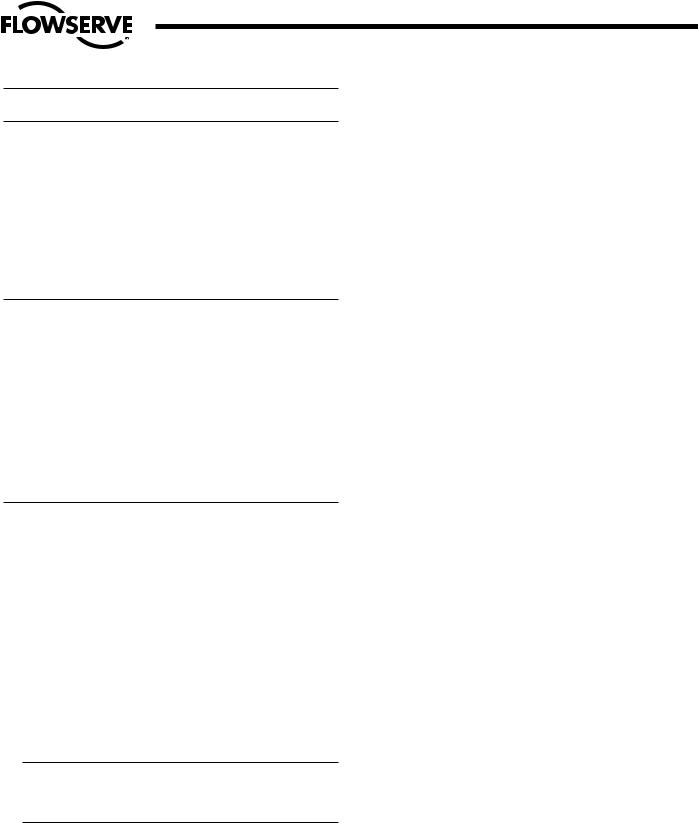Flowserve Cryogenic Ball Valves User Manual

Worcester Controls |
08164-S |
Cryogenic Ball Valves
Installation, Operation and Maintenance Instructions
1/4" – 2" R5 AND EARLIER THREE-PIECE, BODIED EXTENDED BONNET
1/4" – 2" R6 AND EARLIER C4 THREE-PIECE BODIED NON EXTENDED BONNET
3" – 6" R12 AND EARLIER ONE-PIECE BODIED EXTENDED AND NON EXTENDED BONNET 1/4" – 2" R6 AND R7 C44 THREE-PIECE BODIED NON EXTENDED BONNET
IMPORTANT: Valves intended for ammonia service must be of stainless (not brass) material, with welded bonnet joint. The standard bonnet joint is brazed, not welded.
CAUTION: Flowserve recommends that all products which must be stored prior to installation be stored indoors, in an environment suitable for human occupancy. Do not store product in areas where exposure to relative humidity above 85%, acid or alkali fumes, radiation above normal background, ultraviolet light, or temperatures above 120°F or below 40°F may occur. Do not store within 50 feet of any source of ozone.
I. INSTALLATION
A.The Worcester Cryogenic Valve is unidirectional for flow in one direction only and therefore can only be installed in one direction. With the valve in the closed position, install it with the relief hole in the ball on the upstream side to ensure that cavity relief is upstream. Note arrow stamped on the body, on a metal tag welded to the body, or on the bonnet plate indicating flow path.
B.The Worcester Cryogenic Diverter Valve must be installed with the bottom port on the upstream line.
IMPORTANT: DO NOT install valves with extended bonnets with the extension tilted more than 30° from the upright vertical position.
The extended bonnet valve is designed to maintain stem seals at normal ambient temperature. Do not insulate the extension fully —allow 3"–4" of tube to protrude above the insulation.
C.To install valves with welded, brazed or soldered pipe ends (BW, SW, SWO or TE):
NOTES: Prior to welding or brazing, THOROUGHLY CLEAN ALL JOINT SURFACES to prevent contamination.
Worcester brass valves are of leaded forging brass. Brazing cannot be successfully accomplished unless a white flux is used.
1.Tack weld the valve in place.
2.Remove three body bolts, loosen the fourth, swing out body with ball open. Close the ball and remove the seats, ball and body seals. (Discard the body seals when removed from the valve.) Note the position of the seats so that they can be replaced in the same position as they were removed.
3.Swing body in and secure it with one additional bolt diagonally from first.
4.Weld pipe ends. When gas welding, DO NOT play the flame upon the valve body.
5.Allow the valve to cool and then reassemble with ball, seats and the new body seals that are included with the valve.
6.IMPORTANT:
The fluoropolymer-coated stainless steel gaskets that are included with the Worcester 1/4"–2" Cryogenic Valves make excellent seals, however, some points of caution in their use require emphasis:
a.The gaskets are NOT reusable. Upon removal from valve, they should be discarded and replaced with new parts.
b.Avoid scratching the fluoropolymer coating of the gaskets during installation. Light lubrication of these seals can help to prevent damage.

Flow Control Division
Worcester Controls
c.“S” type gaskets are installed with their widest flange to the valve body (See view A on page 6).
d.Swing center section back in line.
e.Tighten and torque body bolts evenly, alternating in a criss-cross diagonal pattern. Use torque figures below:
Bolt Diameter |
in-lb |
ft-lb |
1/4" |
72-94 |
6-8 |
5/16" |
120-144 |
10-12 |
3/8" |
192-216 |
16-18 |
7/16" |
336-384 |
28-32 |
1/2" |
504-552 |
42-46 |
D.When installing the 3"–6" Worcester Cryogenic Valves, use standard gaskets which are suitable for the specific service. Tighten the flange bolts or studs evenly and in proper tightening sequence.
E.Please note: on the 3"–6" flangeless short pattern valves (151 or 301), the ball protrudes slightly from each port. After determining the proper valve position (i.e., relief hole in ball from section I.A), open the ball before installation to avoid damaging it.
II. OPERATION
A.To operate the Worcester Cryogenic Ball Valve, turn the stem 1/4-turn clockwise to close and 1/4-turn counter-clockwise to open.
On manually operated 1/4"–2" valves, the handle acts as a pointer. When it points across the pipeline, the valve is closed.
On manually operated 3"–6" valves, the stop plate acts as a pointer. When it points across the pipeline, the valve is closed.
B.To operate the Worcester Cryogenic Diverter Valve, rotate handle 1/4-turn to divert the flow from the bottom port to either of the side ports. (The diverter valve also comes with a special 180° ball and stop plate. In this case the handle would be rotated 1/2-turn and the handle would point to the port to which flow was diverted.)
C.These valves will provide positive shut-off when used in accordance with Worcester’s Cryogenic Valve pressure/temperature chart.
D.DO NOT leave the ball partly open. DO NOT throttle with Worcester’s Cryogenic Valves. It will result in seat breakage.
E.DO NOT allow media which can solidify, crystallize or polymerize to stand in the valve cavity.
F.Torque Requirements:
The valve torque will vary depending on the length of the time between cycles, line pressure, type of valve seats, and the media in the system.
All figures in the following table are based on laboratory tests with LN2 as the media. These figures should approximate the actual valve torques. For a more detailed analysis of valve torque requirements, see Worcester’s Actuator Sizing Manual.
|
Maximum Expected |
|
Maximum Expected |
Valve Size |
Breakaway Torque |
Valve Size |
Breakaway Torque |
1/4"–1/2" |
80 in-lb |
2" |
625 in-lb |
3/4" |
150 in-lb |
3" |
1100 in-lb |
1" |
200 in-lb |
4" |
1500 in-lb |
|
|
|
|
11/2" |
475 in-lb |
6" |
2200 in-lb |
III. MAINTENANCE
The Worcester Cryogenic Valve with the extended bonnet normally operates with the bonnet at a higher temperature than the valve. Because of this, there will be a frost line about two-thirds of the way up the extension. If the bonnet becomes covered with frost, it’s an indication that the stem seals are leaking.
Whether the valve has an extended bonnet or not, if stem leakage is noted, then adjust the stem nut per the following procedure:
A.Stem Seal Readjustment Procedure:
CAUTION: Excessive tightening causes higher torque and shorter stem seal life.
1.Allow the valve to warm to ambient temperature.
2.1/4"–2" Valves with Two Stem Nuts and Lockwasher:
a.On manual valves, loosen the handle nut or handle assembly bolt (as applicable) to allow easy access to the stem seal retaining nut. On actuated valves, loosen top nut.
b.While holding the stem to prevent turning, tighten the stem seal retaining nut until Belleville washers are flat (the nut will bottom); then back off 1/6 turn.
c.Retighten the handle nut or handle cap screw (as applicable) while making certain that the stem seal retaining nut and stem are immobile.
3.1/4"–2" Valves with Self-Locking Stem Nut and Four Belleville Washers:
a.Tighten self-locking stem nut until Belleville washers are flat (the nut will bottom); then back off 1/3 turn.
2 |
08164-S |

Flow Control Division
Worcester Controls
CAUTION: The self-locking stem nut is difficult to tighten and must fully flatten the Belleville washers before backing off.
4.If seepage is noted at stem on 3"–6" valves, tighten retaining nut 1/6-turn at a time until seepage stops.
IV. REBUILDING
THIS MANUAL CONTAINS EXPLODED VIEWS OF ALL VALVES COVERED BY THE TEXT. THEY HAVE BEEN INCLUDED TO AID IN THE REBUILDING OF THE VALVE. PLEASE REFER TO THEM WHEN FOLLOWING THE WRITTEN INSTRUCTIONS.
a WARNING: BALL VALVES CAN TRAP PRESSURIZED FLUIDS IN
BALL CAVITY WHEN CLOSED. If the valve has been used to control hazardous media, it must be decontaminated before disassembly. It is recommended that the following steps are taken for safe removal and disassembly:
•Relieve the line pressure. Operate the valve prior to attempting removal from line.
•Place valve in half-open position and flush the line to remove any hazardous material from valve.
•All persons involved in the removal and disassembly of the valve should wear proper protective clothing such as face shield, gloves, apron, etc.
A.A standard repair kit can be ordered for the Worcester Cryogenic Valve containing all necessary parts for normal valve rebuilding. To order a repair kit you must specify the size, type of valve (extension or no extension), “RK44” and revision (“C” or “R” and number). This information is found on the valve body, stop plate, handle, valve nameplate, or mounting bracket nameplate.
Example: 1/2" CN RK44 R6 (The “N” indicates there is no extension) or 3" C RK44 R12.
If the valve is a non-standard product, then there is a fivecharacter code called a “P”, “T”, “C”, or similar number, found on the valve body, stop plate, handle, valve nameplate, or mounting bracket nameplate. To order repair kit, include size, type of valve, “RK44”, and “P”, “T”, “C”, or similar number.
Example: 1/2" CRK44 P2577 or 1/2" CNRK44 TO726
CAUTION: If the seats and seals installed differ from those removed, the valve nameplate or stop must be replaced or remarked to indicate the altered materials and ratings, or the valve must be tagged to so indicate.
B.If replacement parts other than those included in the repair kit are needed, order the part by name and size, including the complete valve code. For non-standard product add “P”, “T”, “C”, or similar number, see valve body, stop plate, handle, valve nameplate, or mounting bracket nameplate for this information.
Example: Ball, 1/2" C416 PM SE R3 or Ball, 1/2" CN466 PM SE TO914
Porting (if diverter cryogenic valve) must also be specified when ordering these parts – Example: Ball; 1" C416 PM SE V1 R6.
To Replace the Seats and Seals in 1/4"–2" Cryogenic Valves:
NOTE: If stem seal replacement is not required, omit Steps 5, 6, 7, 10, 11, and 12.
C.1. Open valve.
2.Remove three body bolts and loosen the fourth and swing the center section out from between pipe ends or remove all four bolts and remove valve from line, whichever is more convenient.
3.Close valve.
4.Remove the ball, seats and body seals. Discard seats and body seals.
5.If present, remove handle nut, lockwasher, handle and stop plate. Remove retaining nut or self-locking stem nut, Belleville washers and stem seal follower(s). On valves with a handle and stop plate assembly, first loosen handle socket head cap screw, then remove handle nut and proceed with disassembly.
Valves Without Extension
6.Push stem into the body cavity and remove thrust bearing(s) from stem, then remove the stem seals and stem seal protector (if any) from body.
Valves with Extended Bonnet:
7.a. Push stem into body cavity.
b.Remove pin from stem.
c.Unscrew bottom tang of stem from stem extension (right-hand thread).
d.Remove thrust bearing from stem bottom tang.
e.Push stem extension out of body.
f.Remove fluoropolymer stem seal and metal seal washer (follower).
Follow Steps 8, 9 & 10 for Both Extended and Non-Extended Valves:
8.Clean all sealing surfaces of valve including the ball.
9.Inspect the ball and the surfaces against which the seats and seals are installed, they should be undamaged, clean and free of pit marks and scratches. Light marring from the action of the ball against the seats is normal and will not affect the operation of the valve. Flaws which can be seen but barely detected with finger tips are acceptable. The stem and body
08164-S |
3 |
